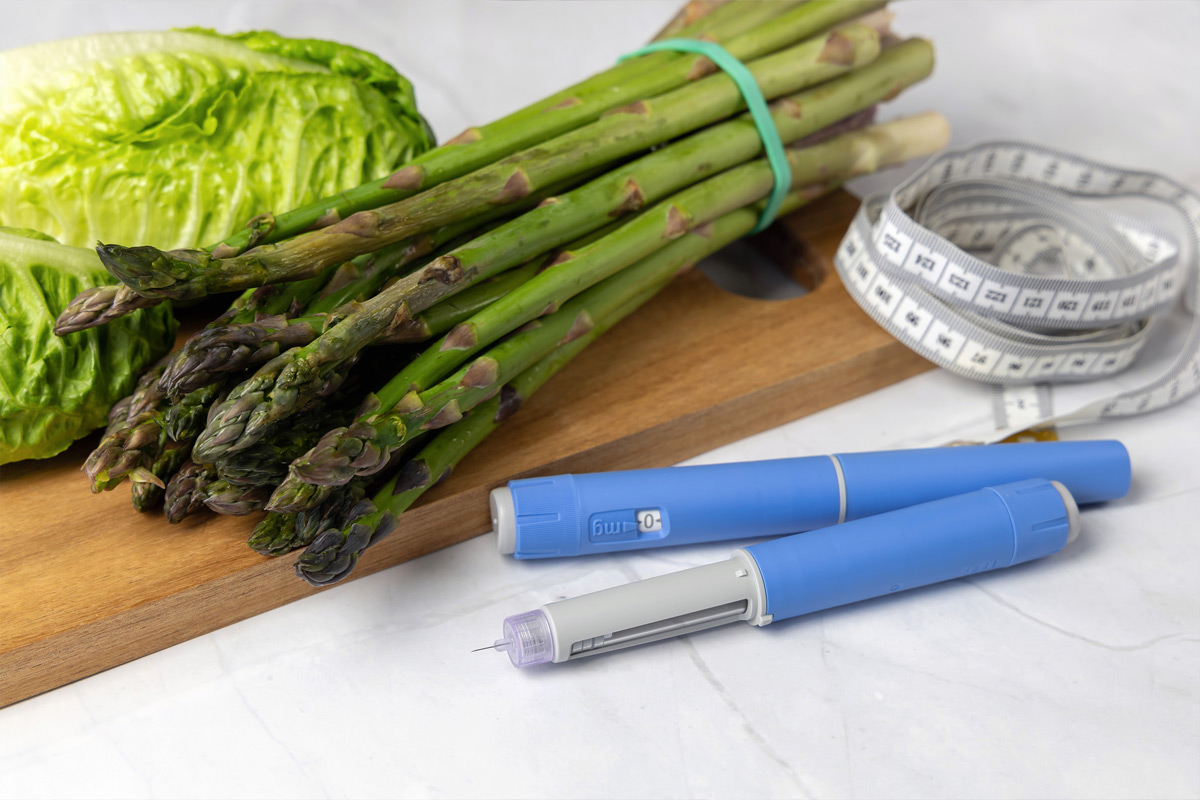GLP-1 stands for glucagon-like peptide-1, a hormone that influences various metabolic functions. Special cells in the gut lining secrete GLP-1 both rhythmically and in response to nutrient contact (12). Peak concentrations occur about 45-60 minutes after a meal, and then levels gradually decrease until food is ingested next (15). Natural GLP-1 levels rise during meals and can vary based on meal size and composition (8). Some studies show that GLP-1 secretion is impaired in people with insulin resistance and obesity (18).
How Does the Body’s Natural GLP-1 Work?
The hormone GLP-1 works by:
- Stimulating the body to produce more insulin, a hormone that helps lower blood sugar levels.
- Reducing the production of glucagon, another hormone that typically raises blood sugar levels.
- Activating stretch receptors in the small intestine to send signals that help you feel full even when consuming less food.
- Slowing the rate at which food moves out of the stomach, prolonging the feeling of fullness.
All these functions work together to lower your blood glucose levels and increase feelings of fullness with less food.
What Is Ozempic?
Ozempic is a brand name for synthetic peptide medications like semaglutide and tirzepatide, which are GLP-1 receptor agonists. Other brand names include Mounjaro, Trulicity, Wegovy, and Zepbound, among others. These medications are used alongside diet and exercise to improve blood sugar levels in adults with diabetes. They are administered once a week via injection in the abdomen, thigh, or upper arm, mimicking the effects of a naturally occurring hormone called GLP-1.
Natural GLP-1 vs. Synthetic GLP-1 Receptor Agonists
- Natural GLP-1 is produced in the gut when eating and helps release insulin for energy conversion. It is quickly broken down after food digestion to prevent excessive insulin (which could cause low blood sugar) and maintain metabolic balance.
- Synthetic GLP-1 receptor agonists, like semaglutide, are synthetic versions of GLP-1 that resist the natural enzymatic breakdown in the body, lasting longer (often for days after one injection). Proper nutrition is crucial when using these medications to avoid muscle wasting due to decreased appetite and inadequate nutrient intake.
Long-Term Considerations Using GLP-1 Agonists
Semaglutide may improve A1c levels and aid in weight loss. However, if someone stops taking this medication without changing their eating and physical activity habits, they will likely regain the weight they lost. This happens because their appetite will return to its previous level, and the necessary lifestyle changes will not have been made. A study compared two groups: one group took semaglutide for about 4.5 months and then switched to a placebo (an inactive drug) for about 11 months, while the other group took semaglutide for the entire time (about 1.5 years). Initially, everyone in the study lost weight, but those who received the placebo after week 20 gradually regained weight.
One major takeaway is that achieving lasting success in A1C and weight management requires incorporating healthy lifestyle changes into your daily routine.
Some potential side effects of this medication include gastrointestinal issues such as constipation, diarrhea, nausea, vomiting, and abdominal pain. There is also an association with an increased risk of pancreatitis, vision impairment, and a thyroid cancer called medullary thyroid carcinoma (MTC) (4). It’s essential to discuss these risks with a healthcare provider or pharmacist, along with any other concerns.
Increasing Natural GLP-1
Something as simple as eating more fiber can significantly enhance your body’s ability to produce GLP-1 naturally. Consuming high-fiber foods like vegetables, fruits, legumes, and whole grains not only supports digestive health and regulates blood sugar levels but also stimulates the release of GLP-1 in the gut. Fiber promotes a diverse gut microbiome, and the breakdown of fiber increases the beneficial gut bacteria that produce short-chain fatty acids (SCFAs). These acids also boost the production of GLP-1 in our intestines.
Unfortunately, many people in America don’t consume enough fiber. Without sufficient fiber, the gut microbiome loses its ability to produce adequate SCFAs, resulting in decreased GLP-1 levels. This can lead to increased appetite, insulin resistance, and difficulty losing weight.
Clinical Significance
Addressing fiber deficiency through dietary interventions, such as consuming more fruits, vegetables, whole grains, and legumes, can support gut microbiome health, enhance natural GLP-1 production, and improve metabolic outcomes. The Recommended Dietary Allowance (RDA) for dietary fiber varies by age and gender. Adults and children over 4 years old should aim for a daily intake of at least 28 grams of dietary fiber (19).
These recommendations can vary based on individual health conditions, activity levels, and specific dietary needs. It’s important to include a variety of fiber sources, such as fruits, vegetables, whole grains, nuts, and seeds, to meet daily fiber goals and promote digestive health.
Additional Ways to Increase Your Natural GLP-1 Levels
There are several natural methods to enhance GLP-1 levels in your body, which can support better blood sugar management and overall health:
- Include Protein and Healthy Fats in Meals: Research suggests that consuming a diet rich in protein and other nutrients can increase GLP-1 secretion and promote satiety (10,15,16). Research shows that specific amino acids like L-tryptophan, alpha-linolenic acid, and phenylalanine can enhance GLP-1 secretion and delay gastric emptying. Consider incorporating foods rich in these amino acids into your diet, such as walnuts, pinto beans, chia seeds, flax seeds, leafy vegetables, pumpkin seeds, sunflower seeds, red cabbage, and fermented tofu.
Additionally, integrating sources of healthy fats like avocados, nuts, seeds, and olive oil into your meals can help regulate blood sugar levels and potentially support GLP-1 production (14). - Regular Physical Activity and Stress Management: Physical activity significantly influences the composition of the human gut microbiota (15). Consistent physical movement and resistance training have been shown to enhance GLP-1 levels beyond dietary factors alone (11). Aim for at least 150 minutes (about 2 and a half hours) of moderate-intensity exercise per week, as recommended by health guidelines (6,17). Here’s a breakdown of what 150 minutes per week might look like:
- 22 minutes or more per day if you exercise 7 days a week
- 25 minutes or more per day if you exercise 6 days a week
- 30 minutes or more per day if you exercise 5 days a week
Physical activity also aids in managing chronic stress, which can influence dietary choices that impact the gut microbiome and GLP-1 production. Consider incorporating stress-reducing techniques such as mindfulness meditation, yoga, deep breathing exercises, or engaging in enjoyable hobbies to support overall health.
- Get Quality Sleep: Research indicates that individuals with sleep apnea experience reduced GLP-1 secretion (13). The severity of sleep apnea correlates with the extent of this decrease. If you exhibit symptoms such as loud snoring, excessive daytime sleepiness, morning headaches, or waking up gasping or choking, it’s advisable to consult with your healthcare provider to determine the most suitable treatment plan for you.
Incorporating these natural strategies into your daily routine can enhance your overall health and well-being. Schedule an appointment with our Tula nurse or dietitian to ask questions and explore how you can integrate a healthy lifestyle and medications to support your health journey effectively.
You have the power to make well-informed decisions about your body and health with guidance from your healthcare provider. At Tula, we’re here to support you at every step of your health journey. We encourage you to investigate the research on your own and ask questions. Below are some resources where you can find information to aid in making informed decisions. Every choice, whether big or small, plays a significant role in shaping the unique and wonderful person you are becoming!
Sending Health Your Way!
Tula Clinical Team
Reviewed by:
Aubree RN, BSN
Austin MS, RDN, CSR, LDN, CD
Tula Takeaways |
|---|
| 1. Understanding Semaglutide (Ozempic): Ozempic is a GLP-1 receptor agonist used alongside diet and exercise to improve blood sugar levels and aid in weight loss in adults with diabetes. |
| 2. Long-Term Considerations: While effective in the short term, discontinuing semaglutide without lifestyle changes can lead to weight regain and increased A1c levels. Sustainable health benefits require consistent, healthy eating and regular physical activity. Side effects should also be considered when deciding to go on a lifetime drug. |
3. Natural Ways to Boost GLP-1 Levels:
|
The LIVE TULA blog is informational and not medical advice. Always consult your doctor for health concerns. LIVE TULA doesn’t endorse specific tests, products, or procedures. Use the information at your own risk and check the last update date. Consult your healthcare provider for personalized advice.






